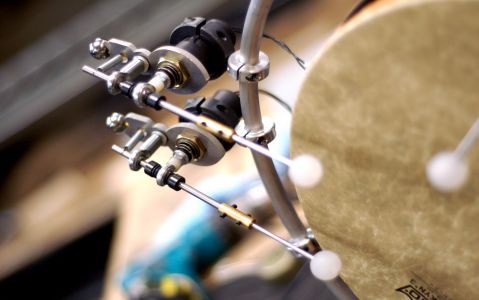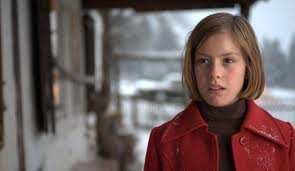Robots and robotics
Last revised 2/16/2018. Return to Major
concepts. See sculpture. emotion,
expression.
- Our posts and references.
All the aartists of the specialty we know of are listed in our Index, with direct link on their Diccan's item. On summer 2014, we list some 35 artists.
We concentrate here on conceptual considerations and the state of the art. The historical development of the field is described, period after period, in our history of digital art
- An online review : Robotics business review.
- Exposition at Musée des arts premiers
-
Exposition in 2015 at Cité des Sciences. A critical post. Monumental bodies, small brains.

Famous among the famous ones, R2D2 and 6PO (Starwrars)
Robots can be considred as central in the digital art realm, since they cas as well work as tools, as partners, as artists by themselves, as critics, and.... rarely, works of art.
Note that the term robot was created to present humans reduced to a machinic state (Capek), and that this meaning is frequently mixed with its opposite, a humanoid machine.
1. Robots as works of art
- Index of roboticist artists in diccan
A robot is never considered as an artwork. This taboo is absolute, and so
more so as it is never explicitly stated. This is true, a fortiori, for humanoid
robots (but perhaps Orellana, and in the
Japanese world)
- See uncanny valley.
- See Gundam, the robot which everybody loves, at least in Japan. But is it
art?
- Let us not forget Wall.E and his girlfiend Eva. In this Disney film, they
are the true saviors of mankind. Rare!
- The first episode of Star Wars had let expect something positive about robots,
and notably since the design and language facets of R2D2 and 6P0, as well
as their complementarity, had been given special care. Unfortunately, the
sequels and prequels got back to simplistic psychology for humans and so more
for robots.
- Most of art works about robots are derisive. They are mainly paintings representing
robots, or still sculptures made from diverse objects, or even automated objects
without humanoid form.
- Matthew Brand is an important excception, with his artistico-robotical
experiences at Media Lab (MIT) around the topic: "A robot may be an artist".
But, since then, he went to Mitsubishi and works on more serious topics, as
says his present web page: "Matthew Brand studies unsupervised learning from
sensory data. One goal is to make machines that learn to realistically mimic
and augment human performances; another is to optimize systems that serve
the conflicting interests of large numbers of people." Nevertheless, his aims
remain ambitious and provocative.
- "Robots are lords of the dance", at Seoul's dance
festival (2010)
< Art in the Age of Technoscience. Genetic Engineering, Robotics and
Artificial Life in Contemporary Art. Springer, Vienna, 2009.
- Olivier
Decatoire , derisive robots, not real material robots.
- Francis Simon .
His page does not give a real understandig of his art. He is represented by
galerie Balech.
- Max (a robot maximizing its variety),
the selfish and ironic robot, by Pierre Berger, using analog electronics,
1979 (disposed of since then). Descriptive article in French.

An accompanist robot.
2. Robots as artists
This topic is provocative, but less taboo than the former one. Some examples:
- In general
- Website of Les automates intelligents. Art index.
- Games, interaction, storytelling. See games.
- A lot in Digital Storytelling. A creator's guide to interacdtive entertainment. [Miller, 2014].
- Painters
- It paints when you sleep. Nice. See Soonsoon
- (forerunners) The Métamatic machines by Tinguely
- An industrial robot was painting (poorly) at Siggraph (1997).
- A drawing robot at Laval Virtual 2010. (An ordinary industrial robot, controlled by a famed comic artist, Jean-Claude Fournier (Spirou).
- Cinema
- A film maker robot AH No 64 (Feb. 2002. biblio)
- Music and live performance
< La robotique dans le monde des spectacles. An article by Cédric Vasseur in Planète-Robots may-june 2011.
- Music accompanist robot Cal Arts Robot Orchestra (image ci-contre)
- Robot eDavid Vimeo. 2013, industrial robot, with a developed system of paint handling, and some aesthetic criteria applications.
- Faites entrer les artistes. 4 pages in Planète Robots, sept-oct 2012.
- Writers (algorihtms, and not humanoid robots)
- Prose writers and poets. See our writing notice.
- Journalits. See some notes in our writing notice.
3. Robots as critics
"To build a site accessible to the robots which explore the Web is as important as to design the site for the internauts..."(Danny Sullivan, rédacteur-en-chef de SearchEngineLand.com)
- The Berenson robot has been used in Quai Branly (2012) of 'museum as an art critic. A page with a video .
- Roxame includes critic functionalities and is able to write an HTLM report.

4. Robots as an art subject
Conflictual relations between humans and robots have always (since antiquity) been a subject for art. This theme was more frequent in the 2000's (less around 2015). Up to recently, only the Japanese were seeing robots as friends and allies if not saviors. The most famed of us is Astro Boy, by Osamu Tezuka. In 2008, Disney broke new ground with the so cute Wall-E (et his loved Eva), when the two versions of Tron remain in an apposition philosophy.
In 2011, two films pushed farther, with even more human robots.. up to be played by flesh and bone humans !
Kike Maillot proposes Eva and comment (our translation from French): "What takes me is to talk about the way you enter in relation with somebody and fall in love (be it a human being or a machine" (an interview with Planète robots (may-june 2012). But "the film centers mainly upon the relations between humans". The film did not stay long in projection rooms, and Télérama (may 16-22, 2012) was not really fond of it "A quite obsolete reflexion about soul endowed robots". By contrast, Cinema Jeux Actu and Abus de Cine hailed the images beauty.

Michael Fassbender dans Prometheus, de Ridley Scott
Ridley Scott, with Prometheus has the robot (played by Michael Fassbender) playing a mediator part in a complex scenario. A prequel (épisode written after a work but logically anterior) of Alien.
On a totally different note, Galerie Charlot exposs works by Zaven Paré, which explore the man-machine convergence, in a mood quite near to the "machinic life" studied by [Johnston]. But, in a very different way, Johnston rewrittes computer science sotry, from cybernetics to artificial life, in order to extedn them into the future. By contrast, Paré makes "electronic puppets". Combining cinetic art and video, he is an heir to Tinguely as well as of Nam Jun Paik. But he is a thinker even more than an artist. In his bool Maquinas (7Letras, Rio-de-Janeiro, 2009, text in Portuguese but with a full english translation at the end of the volume), he comments in depth the images of his work. And he adds in front a large preface by Emmanuel Grimaud entitled "The technological animism". This author is known for his book Dieux et robots. Les théâtres d'automates de Bombay (L'Archange minotaure 2008), where he presents the incredible automata that bring animation each year in Ganesh feast in Bombay. Here, he makes mainly echo to the recent works of Masahiro Mori about the uncanny valley.
Let's recall that we enter this "uncanny valley" when the realism of images, mainly representations of humas, become too srong. Quite brutally, we fall from admiration to trouble. We were seeing a machine, more and more admirable as trompe-l'oeil... and suddenly we see a human image spoiled by turning-off imperfections (for example eyes that aim not to the proprer place for the current action). The rupture is specially strong with (see expression). The problem is of minor importance for still images : not at all for painters, a little more for photographs. But it strikes full force in animated iamge. That takes the builders (research labs or industrial firms) to choose a minimalism without ambiguity : Kismet (MIT), or lawn-movers and vacuum cleaners. Japan remains an exception with for instance Actroid-F (the page includes a video which will let the reader to build his own opinion).
5. Robotics in general

Wall-E (Disney), one or the rare frienldy robots in occidental literature.
- Lirec, a European project of robots who show and recognize emotions.
- Robots as artists see it. First part of a series in Planète Robots, May-June 2011.
- Urbi, the robot operating system, has been inopen-source since 2010.
- In architecture, robotization consequences are fare from clear [Picon] p. 169
- Robotic emotions at Siggraph 2008
-
Designing sociable robots. by Cynthia Breazeal MIT Press 2002. (An important MIT lab).
- Contestational robotics (Critical Art Ensemble) website
- Auto-creation of language, Interview of Frédéric Kaplan AH No 42 (in French)
- "The robotic, 16th-note-grid drum machines of ghe seventies influenced the gestures of early rfap much as the new generation of poducers-composers are influenced by the machines they use" ([Moorefield] p.XVIII).
History
- The most ancient mention of something like a robot dates back to Apollodoros who describes Talos, made in Creta (then it would refer to 15th century BC).
"Having sailed again, they reached Creta. But Talos was present and prevented them to enter the harbour. This Talos, as say some, still belonged to the Bronze species; other sources say that it hat been offered to Minos by Hephaistos. It was a man, fully in bronze, even if some say it was a bull. It had only one vein, which ran in all its body, from the neck to the ankles. At the end of this vein, a bronze nail closed it. Talos, as a sentinel, walked everyday around the island. Having seen the Argos ship coming near the coast, it began to throw him heavy stones. But it was embezzled by Medea, and died. Some say that Medeus made him mad with drugs. Others say that Medea promised him immortality, and instead of that, took off the nail which closed the vein, so that all its "ichor" went out, and it died. According to another version, it died because Poeas threw to it an arrow in the heel. "
- The word "robot" has been created by the Csech author
Carel Capek in his novel RUR Rossum's universal robots (1920). A dedicated site. Note that the Capek's robots are enslaved humans, and not machines as we mean today.
- The first industrial robot was developped in the United States in
1962, built by Unimate.
- New topics: all along history, robots become more and more biological; at the same time, humans are infected by naughty roots. Reciprocally, some robots play tor mankind's case. Wilson could go even farther into this sort of convergence. Spielberg will make a film of it, to be presented by Disney in 2013.
Major references:
- A reference book, with a strong synthesis of the domain, technically strong but rather "philo"
: Robot habilis, robot sapiens. Histoire, développements et futurs
de la robotique, by Philippe Coiffet. Hermès 1993.
- L'homme fabriqué. Récits de la création de l'homme
par l'homme. by Jean-Paul Engélibert. Garnier 2000. This book reprints the famed novels of Hoffmann, Shelley, Poe, Barbara, Bierce, Schropp, Villiers de l'Isle-Adam,
Wells, Panizza, Capek, Huxley , Glish and Carter, with an introduction and
presentations by J.P.Engélibert, and extracts from Ovidus, Descartes,
La Mettrie, Baudelaire and Truong).
- And, of course I, Robot, by Isaac Asimov. Doubleday and Cy, 1956.
- For fun, pleasure and an optistic view, Robots and changelings, by Lester del Rey, , Ballantine books 1957.
Other references :
< Trait pour trait, by Josèphe Ghenzer, in Planète Robots May-June 2013. About anthropomorphism.
< A robot with a delicate touch (2012).
< Le robot pensant, by Marie-Noelle Himbert. Editions du Moment 2012.
. Robocalypse games for Nintendo, iPhone, WII.
< Probabilistic Robotics By Sebastian Thrun, Wolfram Burgard and Dieter Fox. MIT Press 2005.
< Robot Ethics. The ethical and social implications of Robotics. edited by Patrick Lin, Keith Abney and George A. Bekey. MIT Press 2012.
- Hubot. A note (in French) about the TV series.
> Eva (2012). Film. Our post.
- Robophilia. Short note about a cover by Comment ça marche. (April 2012),
< The Social Life of Robots. by Alex Wright. 3 pages in CACM 2/2012
< La robotique dans le monde du spectacle. Four pages, signed Cédric Vasseur in Planète Robots no 9 (2012C)
>I Robot by Isaac Asimov (Doubleday and Cy, 1956). A major philosophical work, even though it is fiction.
- L'homme fabriqué. Récits de la création de l'homme
par l'homme. by Jean-Paul Engélibert. Garnier 2000. (Tales by Hoffmann, Shelley, Poe, Barbara, Bierce, Schropp, Villiers de l'Isle-Adam,
Wells, Panizza, Capek, Huxley , Glish et Carter, with an introduction et some
presentations by J.P.Engélibert, and extracts from Ovid, Descartes,
La Mettrie, Baudelaire and Truong).
< Robopocalypse, by Daniel Wilson. Doubleday 2011. The robots against mankind. This is certainly not a new topic. But this book renews it. It is based on a state of the art, from home vacuum cleaners to weaponized drones in Afghanistan. By the way, the author has a PhD thesis at Carnegie-Mellon university.
Some new topics, nevertheless: follwing history, robots become more and more biological; at the same time some humans are infected by the evil robots. The other way round, some robots convert themselves to the Manking cause. Wilson could go still farther in sshis convergence. Spielberg were said to prepare a film , to be presented by Disney in 2013.
. Robocalypse games for Nintendo, iPhone, WII.
- A survey about robots in theater in the text by Louis-Philippe Demers and Jana Horakova Anthropocentrism and the staging of robots, in [Adams 2008 ].
- A lot also in [Whitelaw 2004 ].
- Robot. The future of flesh and machines. Penguin, London, 2002.
- Mind children, by Hans Moravec. Harvard University
Press, 1988. French translation : Une vie après la vie. Editions Odile Jacob 1992.
< La vie sexuelle des robots. by Gilles Marie Baur. Paris, Editions Souffles, 1988. Humor, with some funny illustrations.
- Les robots humains dans dans le mythe et dans la science. by J. Cohen
Vrin, 1968. (philosophical, but with examples)
< Robots chefs.
- An emotional experience, not really art, but... Robot punches human to obey Asimov's Rules. New Scientist (10/13/2010) Paul Marks University of Ljubljana researcher Borut Povse is conducting experiments in which a robot limb repeatedly hits human volunteers on the arm to evaluate human-robot pain thresholds in order to facilitate adherence to Isaac Asimov's first law of robotics, which prohibits robots from injuring people.
Povse says accidental collisions between robots and humans are unavoidable, and the experiments are "taking the first steps to defining the limits of the speed and acceleration of robots, and the ideal size and shape of the tools they use, so they can safely interact with humans."
The tests will continue using an artificial human arm for the purpose of modeling the physical impact of far more severe collisions. The objective is to limit the speed a robot should move at when it detects humans in close proximity to avoid harming them. Baylor College of Medicine biomechanics specialist Michael Liebschner questions the use of pain as a measure of outcome. "Pain is very subjective," he notes. "Nobody cares if you have a stinging pain when a robot hits you--what you want to prevent is injury, because that's when litigation starts."
Robot punches human to obey Asimov's Rules New Scientist (10/13/10) Paul Marks University of Ljubljana researcher Borut Povse is conducting experiments in which a robot limb repeatedly hits human volunteers on the arm to evaluate human-robot pain thresholds in order to facilitate adherence to Isaac Asimov's first law of robotics, which prohibits robots from injuring people. Povse says accidental collisions between robots and humans are unavoidable, and the experiments are "taking the first steps to defining the limits of the speed and acceleration of robots, and the ideal size and shape of the tools they use, so they can safely interact with humans." The tests will continue using an artificial human arm for the purpose of modeling the physical impact of far more severe collisions. The objective is to limit the speed a robot should move at when it detects humans in close proximity to avoid harming them. Baylor College of Medicine biomechanics specialist Michael Liebschner questions the use of pain as a measure of outcome. "Pain is very subjective," he notes. "Nobody cares if you have a stinging pain when a robot hits you--what you want to prevent is injury, because that's when litigation starts."
Note the ambiguity of the term : robotized human (Capek) Vs. robotic machine (the current meaning)..
DICCAN'S PARTNERS
